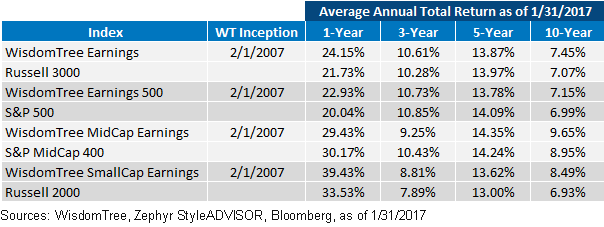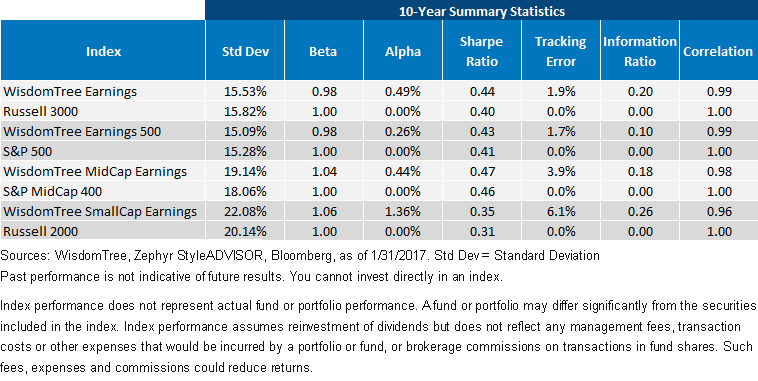WisdomTree’s Earnings-Weighted Indexes Turn 10: How Did We Do?


While many investors evaluate investment managers based on how they’ve performed over the prior three- or five-year periods, 10-year numbers often provide an important lens through which to examine an investment strategy. That’s because most economic cycles and bull markets run out of steam within a decade, and thus 10-year records show how strategies have performed over full market cycles.
In February, WisdomTree’s core earnings-weighted Indexes hit their 10-year anniversary. How did we do? WisdomTree's smart beta Indexes beat beta. In each and every case, WisdomTree’s core earnings-weighted Indexes beat their comparable cap-weighted peers over the past decade. This performance was consistent with what we saw in our research: the more inefficient the market, the greater the opportunity to generate excess returns with a fundamentally weighted approach. The WisdomTree SmallCap Earnings Index, for example, outperformed the Russell 2000 Index by more than 150 basis points (bps) annualized over the past 10 years.

For definitions of terms and indexes in the charts, visit our glossary.

It’s important to note that these excess returns were not generated by taking on excessive risk. In each and every case, the WisdomTree earnings-weighted Indexes generated higher risk-adjusted returns as measured by a higher Sharpe ratio. They also demonstrated very high correlations to the established cap-weighted benchmarks.
Rationale for Earnings-Weighted ETFs
I am often asked how to use earnings-weighted exchange-traded funds (ETFs) in a broader allocation, and why WisdomTree believes such excess returns may persist into the future.
WisdomTree’s core earnings-weighted ETFs can be used in the core of a U.S. equity allocation. They provide exposure to the four broad size segments of the U.S. market. The initial universe is all companies incorporated in the U.S. with market capitalizations of at least $100 million that have generated profits in the prior year. That’s typically around 2,000 companies, with an aggregate market capitalization that is larger than that of the S&P 500 Index and about 90% of the Russell 3000 Index.
Because WisdomTree only includes profitable companies at the annual rebalance in December, we are able to assign constituent weights based on the total amount of earnings a company has generated in the prior year, rather than its market value. This typically reduces the price-to-earnings (P/E) ratio of the earnings-weighted Index relative to its cap-weighted peer—in effect giving investors who buy its tracking ETF a way to “own the market” at a more reasonable price. That reduction in P/E ratio has occurred for each of the WisdomTree Indexes highlighted above at each annual rebalance for the last 10 years.
This selection and weighting methodology allows WisdomTree to replenish exposure to the smart beta factors of value and quality each year. And selecting by market cap for the size-segmented Indexes allows us to minimize “size bets” in the large and broad market Indexes, while maximizing the size bet in the mid- and small-cap Indexes.
The earnings-weighted ETFs share much in common, philosophically, with our dividend-weighted ETFs. But there are three important differences.
First, Morningstar categorizes the core dividend-weighted ETFs we launched more than a decade ago in the Value Category. Our four core earnings-weighted ETFs are categorized as Blend.
Second, the earnings-weighted ETFs typically have less exposure to the real estate investment trust (REIT) and Utilities sectors, so different sector exposures mean that earnings-weighted ETFs perform differently from dividend-weighted ETFs during different phases of the economic cycle. For example, the WisdomTree Midcap Earnings Fund (EZM) and the WisdomTree SmallCap Earnings Fund (EES) have, on average, outperformed the S&P 500 over the past decade during periods when interest rates rose in the U.S.
Third, for investors looking to maximize the capital appreciation portion of the total return, as opposed to the dividend income portion, WisdomTree’s earnings-weighted ETFs offer an excellent complement to our dividend-weighted ETFs.
Conclusion
The WisdomTree earnings-weighted ETFs that track core earnings Indexes approach the standardized 10-year track record in March. For investors looking to migrate assets from the mutual fund structure into the ETF structure, we believe they represent an excellent choice for those in search of low-fee alpha.
Important Risks Related to this Article
There are risks associated with investing, including possible loss of principal. Funds focusing their investments on certain sectors and/or smaller companies increase their vulnerability to any single economic or regulatory development. This may result in greater share price volatility. Please read the Fund’s prospectus for specific details regarding the Fund’s risk profile.
The Global Industry Classification Standard (“GICS”) was developed by and is the exclusive property and a service mark of MSCI Inc. (“MSCI”) and Standard & Poor’s (“S&P”), a division of The McGraw-Hill Companies, Inc. and is licensed for use by WisdomTree Investments, Inc. Neither MSCI, S&P nor any other party involved in making or compiling the GICS or any GICS classifications makes any express or implied warranties or representations with respect to such standard or classification (or the results to be obtained by the use thereof), and all such parties hereby expressly disclaim all warranties of originality, accuracy, completeness, merchantability and fitness for a particular purpose with respect to any such standard or classification. Without limiting any of the foregoing, in no event shall MSCI, S&P, any of their affiliates or any third party involved in making or compiling the GICS or any GICS classifications have any liability for any direct, indirect, special, punitive, consequential or any other damages (including lost profits) even if notified of the possibility of such damages.


